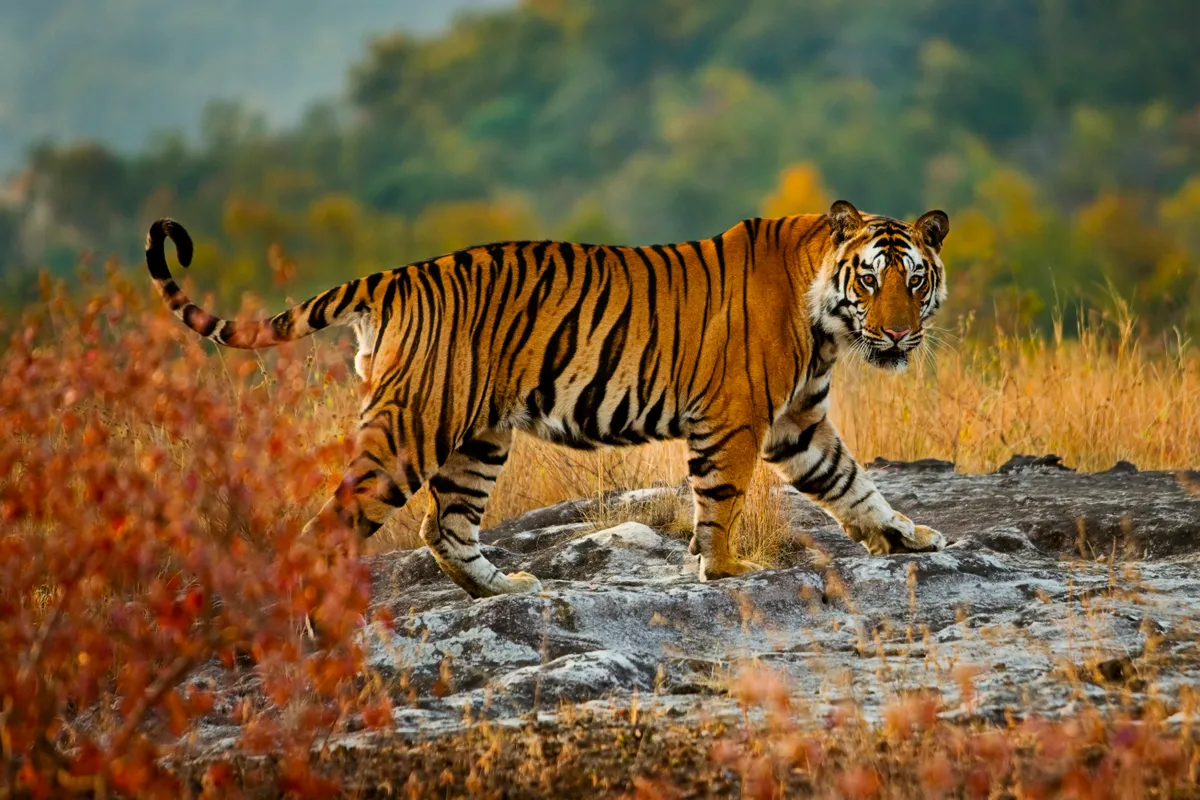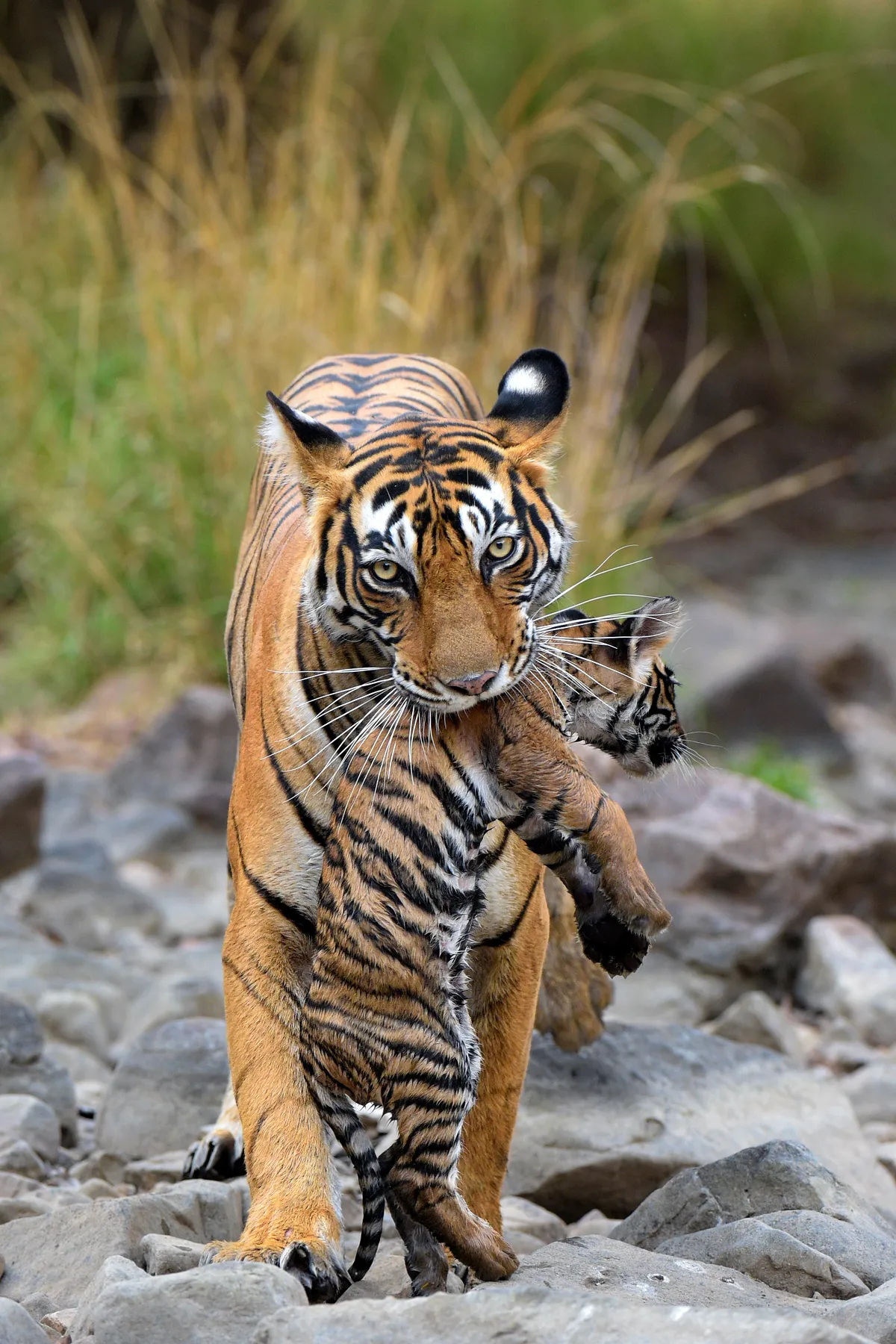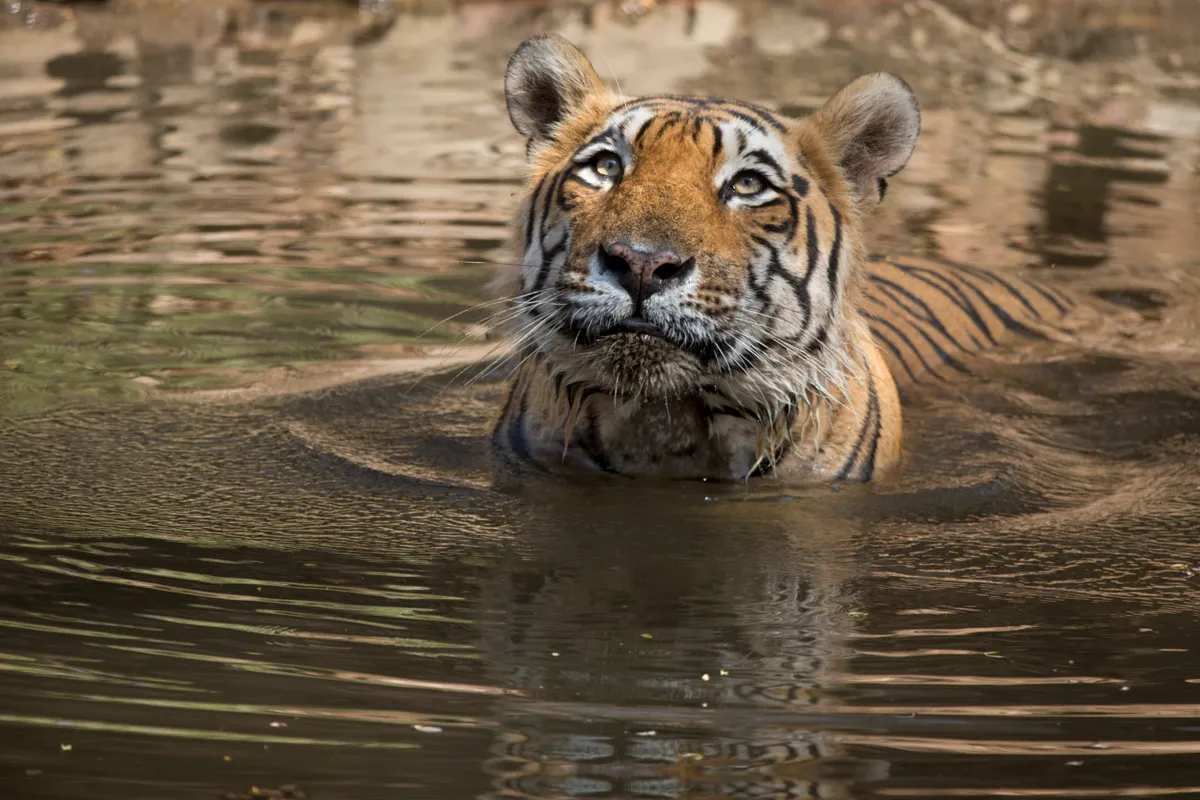Tigers are an iconic species, with their distinctive orange coats and black stripes. In fact, each tiger's pattern of stripes is unique, making it possible to identify different individuals – a handy thing for conservationists trying to keep track of which tigers live where.
These impressive felines are one of the ‘Big Cat’ species and are actually the largest of the cat species, though the prize of the strongest bite (relative to size) belongs to the jaguar.
Here is our expert guide to tigers, looking at key species facts, how they hunt and where they live in the wild.
What is the scientific name of the tiger?
The scientific name of the tiger is Panthera tigris. It is one of five species in the Panthera genus, the others are: lion, jaguar, leopard and snow leopard. These five species are often referred to as the ‘Big Cats’, though sometimes other cat species such as the puma (also known as cougar or mountain lion) and the cheetah are also included in this group.
There are six extant (living) subspecies of tiger:
- Amur (P. t. altaica)
- South China (P. t. amoyensis)
- Sumatran (P. t. sumatrae)
- Indochinese (P. t. corbetti)
- Malayan (P. t. jacksoni)
- Bengal (P. t. tigris)
Why do tigers have stripes?
Tigers are the only big cats to have stripes and individuals can be identified by their pattern.But when it comes to predatory adaptations, you wouldn’t expect a coloration of bright orange with black stripes to be top of the list – in fact it might not be on the list at all.
However, while we typically see tigers in zoos, conspicuous against the green vegetation in their enclosures, their main prey is ungulates, which cannot detect the range of colours that we primates can. To an animal with comparatively poor vision, the cat’s bold, contrasting colours are much harder to pick out in the long grass.

This method of camouflage is an important predatory adaptation. Whereas some large felines rely on co-operative hunting (such as lions) or bursts of intense speed (such as cheetahs), tigers are semi-solitary and depend on their cryptic appearance to ambush prey.
What do tigers eat?
Tigers are carnivorous mammals, and they mostly eat large prey like deer, wild boar and even elephant calves. And yes, they have occasionally been known to kill and eat people, too. This usually only happens when a tiger is old, ill or injured, and therefore unable to catch their normal prey. But once a tiger has a taste for human meat, they often have to be killed to protect the local people.

How do tigers hunt?
A tiger's favourite way of taking down its prey is to lunge at the animal's neck and hold on tight with its powerful jaws. The prey will normally die from suffocation, but some might bleed out first if the tiger's canines sever an artery.
Please note that external videos may contain ads:
Rare Tiger vs Boar Fight | BBC Earth
Is the tiger the world's biggest cat?
Tigers are the biggest cat in the wild, yes. Male tigers can grow to be over 3m long and weigh up to 300kg, while female tigers tend to be a bit smaller.
However, another big cat has been bred in captivity that's even larger. If you breed a male lion with a female tiger, you get a liger. These truly enormous cats have no equal in the modern world, growing up to 3.6m long and being considerably heavier than even the biggest tigers - the largest living cat, Hercules the liger, weighs close to 420kg, and the record is a staggering 550kg.

Where do tigers live?
Tigers are relatively adaptable and historically lived across huge swathes of Asia. There are now very few left in South-East Asia, but they're doing relatively well in India, Nepal, Russia and Bhutan.
Tiger habitats vary by region, with the larger tigers of colder northern regions (like the Siberian tiger) living in the brutal taiga, while smaller tigers from warmer regions can happily live in arid forests, tropical rainforests and flooded swamplands and mangroves.
Researchers think that India holds around half of the world's remaining wild tigers. There are several Indian national parks that are renowned for their frequent tiger sightings, including Bandhavgarh, Ranthambore and Kanha national parks.
The best places to see wild tigers in India
Can lions and tigers co-exist?
India is the only country in the world that is currently home to both of these charismatic big cats, and history and biology say they can indeed co-exist. The felines’ ranges overlapped for millennia across much of western Asia – in India, this was the case into the early 19th century.
Much as predators co-exist in Africa, tigers and lions can live together within carefully drawn boundaries. For example, they may use adjoining habitats, or the same habitats at different times. Behavioural adaptation is another strategy, particularly when it comes to hunting: tigers are largely
killing prey by ambush, while lions are social felids, hunting co-operatively with their prides.
The question of lions and tigers as neighbours is gaining importance in India. The Kuno Palpur Sanctuary in Madhya Pradesh has been ‘prepared’ and is awaiting translocation of a number of Asiatic lions, which survive only in the greater Gir landscape in Gujarat, western India. In the meantime, tigers are moving into Kuno from the famous Ranthambhore Reserve, crossing rivers and ravines along the way.
This Q&A originally appeared in BBC Wildlife Magazine, and was answered by Prenrna Bindra.
Why do tigers have spots on their ears?
Tigers have white spots surrounded by black fur on the back of their ears. It has been suggested that they act as false eyes to warn of their presence or discourage other species from attacking them from behind. Other theories suggest that it helps tiger cubs follow their mother through tall grass.

Apex predators in the wild: which mammals are the most dangerous?
Being an apex predator is tough and, for many species, most pursuits end in failure, while smaller hunters risk losing their hard-won meals to bigger beasts. But which is the deadliest animal and which predator has to work hardest to get a meal? Learn about apex predators and which are the most dangerous?
Do tigers like water?
Tigers do not shy away from water and enjoy bathing in streams and lakes to escape the heat in hot climates.

What are baby tigers called?
Baby tigers are called cubs. In tall grass, rock crevices or caves, tiger cubs are born blind and depend on their mother for protection. Females usually give birth to two to three cubs but can have as many as six.
Each litter has a dominant cub who is more active than their siblings and takes the lead in their play. This sibling is usually the first to leave its mother. After 15 months the matured cubs will disperse and find their own territories.

Please note that external videos may contain ads:
Mother Tiger Learns to Care for Cubs | David Attenborough | Tiger Spy in the Jungle | BBC Earth
How long do tigers live for?
In the wild, tigers have a 14 year life span. Once mature, they will spend most of their time living and hunting alone, with the exception of females when they are raising their young.
###gallery-end###
How big is a tiger's territory?
The range of these big cats can be between 20km to 400km. Tigers in cold northern regions tend to have the largest territories. Scent marking allows tigers to communicate with other tigers in their range, and scratching posts are also useful communication tools, as well as helping to keep their claws sharp.

Can tigers see in the dark?
Tigers have night vision that is six times better than that of humans, which helps them hunt successfully in the dark. A tiger will mainly hunt pigs and deer but is capable of taking prey larger than itself.
How many tigers are left in the world?
The surviving tiger subspecies are the Siberian tiger, South China tiger, Sumatran tiger, Indochinese tiger, Malayan tiger and Bengal tiger. It is believed that between all of those subspecies, there are only 3,000 to 4,500 individuals left in the wild.
The Javan tiger and Bali tiger are sadly both thought to have been hunted to extinction. They were most closely related to the Sumatran tiger (and may have even been the same subspecies), which is still clinging on in Indonesia.
More on tiger numbers:
Why are tigers endangered?
One of the saddest facts about tigers is that land development has led to around 96% of the tiger’s natural range being lost in the past 100 years.
Tigers are also being illegally hunted for their body parts such as bones, skin and teeth to fuel the growing demand for remedies made from tiger parts in Asia.

Are tigers kept in captivity outside zoos?
As well as being illegally poached in the wild, tigers can still be legally farmed for their body parts in China. International trade in tiger parts is banned, but it's a different story domestically, where there's high demand for luxury rugs, tiger skin accessories, tiger bone wine and traditional medicines (which have never been shown to work).
Main image: A female Bengal tiger with cubs at the edge of a pool in Bandhavgarh National Park, Madhya Pradesh, India. © James Warwick/Getty Images


